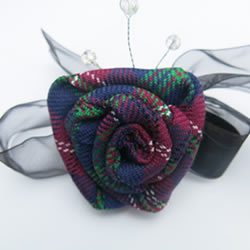Making Your Ceremony Unique
Hand-fasting is an ancient Celtic/Medieval custom, especially common in Ireland and Scotland, in which a couple came together to declare of their own free will that they intended to marry.
While facing each other, the couple will join hands while a cloth is tied around their hands in a knot. This is where the term “tie the knot” came from. Couples often choose to use a cloth made of a particular clan tartan or a specific colour of cloth symbolising something important to them.
Hand-fasting is suitable for use in both weddings and civil partnership ceremonies.
This ceremony involves the bride and groom or civil partners, using individual candles which they will in turn use to light one unity candle. Family and friends will then be invited forward to light their own candles from the unity candle flame in a symbolic act of togetherness and the merging of both families. This ceremony is suitable for all civil ceremonies. The Unity Candle Ceremony is often used in naming ceremonies too as a gesture of unity, symbolising that those present will always surround the child(ren) in a circle of love.
This ceremony requires the couple to provide three containers of coloured sand – one colour for party 1,one for Party 2 and one for the celebrant.
The three containers of sand are then poured into a fourth larger container at different points in the ceremony, each symbolising a different aspect of the couple, their relationship and their families. The sand then forms a pattern in the container, which is kept by the couple as a keepsake of their day.
Children are an important part of every family, may it be your own child, nephew, niece or even just a child that is important to you.
You may like to involve them in your ceremony.
The Oathing Stone is an old Scottish tradition where the couple place their hands upon a stone while saying their wedding vows. Taken from the ancient Celtic custom of “setting an oath in stone”, inclusion of the oathing stone ceremony in the vows can be deeply moving.
During the declaration of wedding vows or civil partnership promises, the couple hold the Oathing Stone, together in their hands. It is believed that holding the stone during the vows in turn casts or sets them in stone.
A Quaich ceremony is a Scottish traditional two handled cup. The Quaich is often referred to as the love cup as you each take a handle to take a drink, showing you trust one another to share the cup. You can fill the cup with a drink of your choice, usually whisky or you can combine two drinks symbolising the two of you becoming one. They also used the Quaich at the reception for their first toast together.
Symbolic of the sharing between the couple, it’s an ancient vessel used by two families or clans, to celebrate a bond, with each leader partaking of the offered drink.
This ceremony involves the couple writing a love letter to each other in the weeks before the ceremony. They will also prepare a special box filled with romantic items such as a CD of their favourite songs, photographs, pieces of poetry and other mementoes.
On the day of the ceremony the box is positioned at the front of the ceremony room. At a chosen part in the ceremony they will each be asked to place their love letters in the box which will then be sealed shut.
Each of the couple keeps one of the two keys to ensure that one cannot open it without the other.
For this ceremony the couple needs to give each other a rose. This can involve the bestman/ witness or other person bringing the roses forward and doing a reading.
Some couples prefer to opt for a straightforward exchange of the roses during the ceremony and others have even chosen to involve their children in the ceremony. The rose ceremony is particularly apt for Valentine’s weddings but works equally well throughout the rest of the year.
This ceremony is suitable for both weddings and civil partnership ceremonies.
A ring warming is when you give your loved ones the opportunity to hold the couple’s wedding bands with a wish, blessing or prayer for your marriage.
By the time your rings make it on to the fingers of the couple they will be saturated with the love of their friends and family.
Following the proclamation that they were now married, the pinning of the tartan would take place.
Each family would customise this, depending on whether the Party 2 or the Party 1 was being accepted into the other’s clan.

Gaelic Blessing
We would be happy to include a short Gaelic Blessing in your Ceremony
“A h-uile latha sona dhuibh, gun latha idir dona dhuibh”
Which translates to “May all your days be happy ones”











